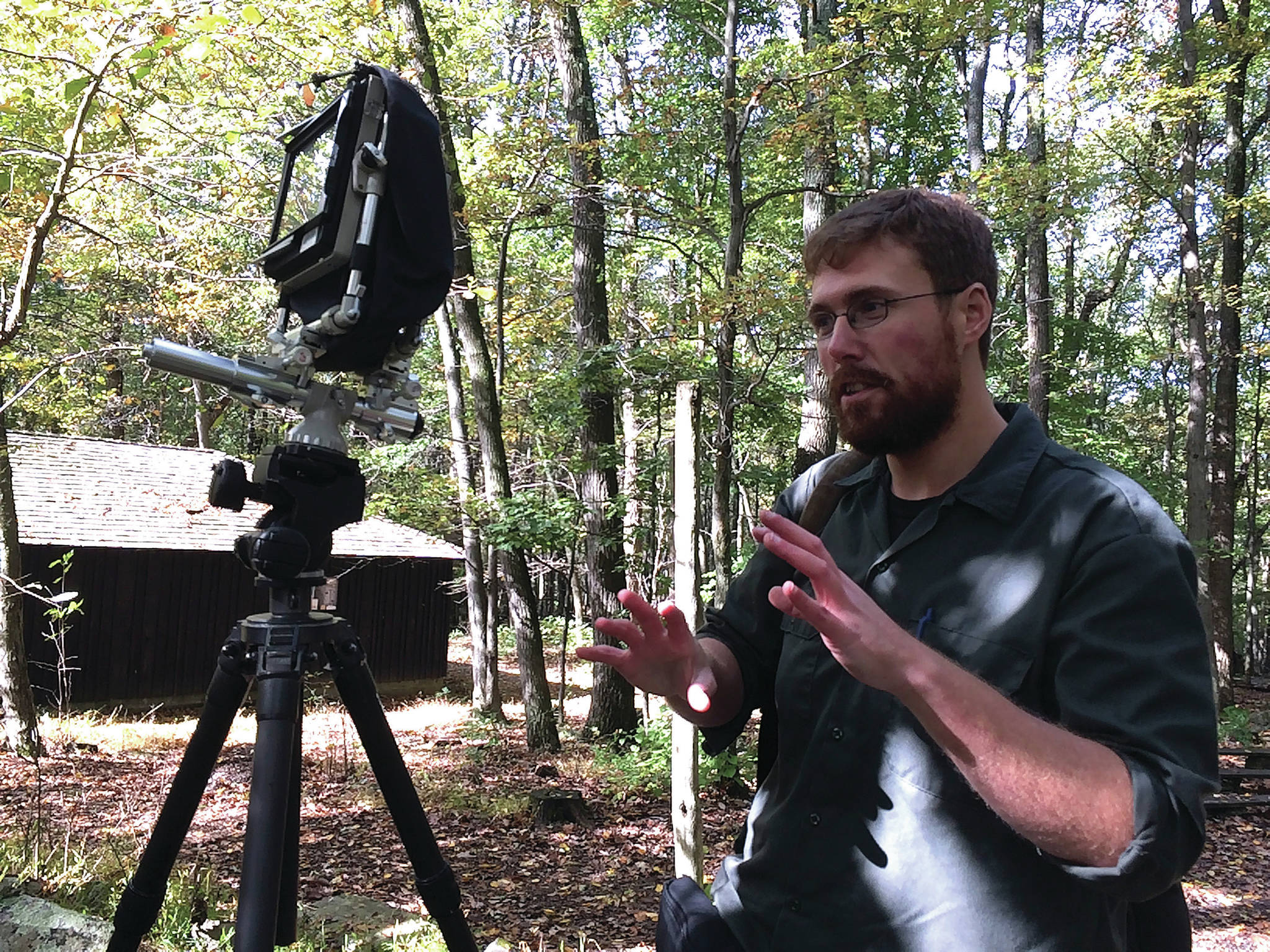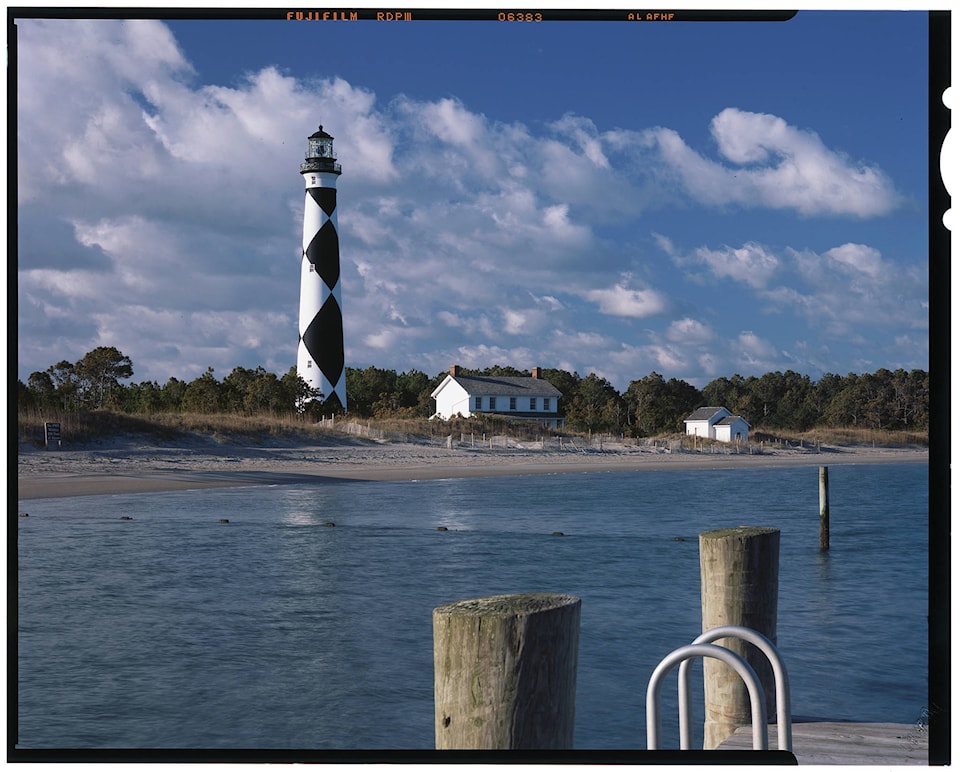Jarob Ortiz stood on a rocky mound and waited. He watched the sky for a break in the clouds and the ground for shadowy patterns. Then, a shazam! of light burst through, illuminating the campfire circle.
“Oh my God, it just got really bright for a second,” he said at Camp Greentop in Catoctin Mountain Park in north-central Maryland. “Excuse me for a second.”
Ortiz ducked under a black cloth attached to his German-made Linhof and viewed the scene in his private cave. Satisfied with the composition and interplay of light and dark, he loaded sheet film into his camera and set the exposure at a very precise 2 minutes, 30 seconds.
“I have to pump up the exposure so you can see the details of the rocks and the shadows under the ledge,” he said. “There is a lot of attention to detail at every step of the process.”
Most photographers snap in time with a hummingbird’s wings, but not Ortiz. Since arriving at the park earlier that morning, the National Park Service photographer had taken two photos. You can’t rush historical documentation — or large-format photography.
“It slows you down,” the 35-year-old said of the art form popularized in the mid-1900s. “You have to be super-selective with your shots.”
Ortiz joined the Park Service in 2016, beating out 4,000 Ansel Adams aspirants for the coveted position. (His backup plan was the U.S. Postal Service.) The former freelance architectural photographer can thank his niche skills for winning the prized job: For years, he has been capturing architectural subjects in black and white using a large-format camera that conjures up an “Olde Tyme” boardwalk attraction.
Upon his hiring, Jet Lowe, a retired large-format photographer with the Park Service’s Heritage Documentation Programs, told Ortiz that he was going to shoot more large format than anyone else in the country. “It’s true,” he said.
Ortiz uses the same model camera (that would be the Linhof Kardan Bi-System 5x7) as Adams, who worked for the Park Service 70 years ago. However, unlike his predecessor, he does not regularly shoot calendar-ready images of our mountain majesties. One of his main responsibilities is to photograph buildings of historical importance for the Library of Congress and its Historic American Buildings Survey, the country’s first federal preservation program, which was founded in 1933.
“People don’t even know these mainstream attractions,” he said. “They interact with them every day, like the visitors’ center, but they just take them for granted.”
Ortiz showers these oft-slighted structures with love and light. On a chilly October weekday at Catoctin, he spent hours photographing Camp Greentop, a handicapped-accessible recreational facility built by the Works Progress Administration in 1938, and Camp Misty Mount, a collection of stone-and-wood cabins, plus a dining hall, constructed during the Great Depression. He has also trained his lens on old cabins slated for destruction at Shenandoah National Park in Virginia; the lighthouse atop Fort Jefferson at Dry Tortugas National Park, off Key West, Florida (missing Hurricane Irma by a week); lighthouses in North Carolina’s Outer Banks; and abandoned facilities on Ellis Island in New York Harbor, his first assignment and one of the most challenging.
“It was so extreme from a technical standpoint. Every single shot was a different situation,” he said of the September 2016 assignment. “I thought, ‘I’m in over my head here.’ “
Fortunately, Ortiz always comes prepared. For the Dry Tortugas assignment, he sent 500 pounds of equipment to the site via FedEx and seaplane. At Catoctin, he filled the back of a Dodge Caravan with his gear, including tripods, battery packs and lighting kits.
He can’t be accused of overpacking. In tricky environments, he needs this stuff. For instance, on Ellis Island, the Baggage and Dormitory Building lacked electricity, so he had to create his own sunshine. He placed high-powered flash heads, connected to battery packs, around the murky space and hid the equipment to avoid any blooper appearances in his images.
“Each light had a specific type of light modifier to produce imagery that looks naturally lit,” he explained. “I used umbrellas, softboxes and sometimes a white wall to bounce the flash off to provide softer and more even light.”
For one image, he set the timer for a nine-hour exposure and left the island for the night. He returned on the early-morning ferry to discover that his game plan had clicked.
Ortiz occasionally braves disquieting conditions, such as spooky sensations, inside the grizzled buildings. “There was a hallway I did not like going down,” he admitted of Ellis Island. Also, at the immigration terminal, he felt a spine-tingling chill inside a graffiti-strewn jail cell that once held political dissidents. The enraged spirits of followers of Castro and Mussolini, perhaps. At Catoctin, he faced more-tangible frights, such as large spiders and a whole snakeskin.
The Milwaukee native didn’t amble down the most photogenic - or direct - path to reach his current career. After high school, he served in the Air Force and was stationed at a base outside Fairbanks, Alaska, for three of his six years. Following his military stint, he returned to the Midwest to become a high school history teacher. Then he changed course, entered journalism school and bought his first camera, a 35-millimeter Olympus OM-2. While studying photography at Milwaukee Area Technical College, he would drive to Detroit and Gary, Indiana, to shoot the bruised urbanscapes. He was so committed to his craft, he would shoot for 24 hours straight, catching only a few hours of sleep before rising to catch the glow of sunrise.
“It was a very grueling schedule,” he said.
In today’s culture of Instagratification, the bearded and bespectacled Ortiz is an outlier. For inspiration and guidance, he looks in the rearview mirror at two of America’s finest: Julius Shulman, who is known for memorializing the creations of such renowned architects as Pierre Koenig and Frank Lloyd Wright, and Adams, who co-minted the Zone System, a photography technique that champions exposure and development. Ortiz said he is attracted to large format’s “discipline, technique and selectiveness,” the opposite of the robotic snap-and-share trend. Another draw: the rush.
“It’s adrenaline,” he said. “Your heart is pumping waiting for the light.”
At Catoctin, Ortiz displayed a deep well of patience as he stood in the cold, waiting for the light to dapple his canvas. He dodged falling acorns and silenced the sirens in his head.
“I am thinking about brook trout fishing in Big Hunting Creek,” he said of the fly-fishing stream near Camp Misty Mount. “If I only had a couple hours to go fishing.”
After several minutes, golden-yellow streamers unfurled from the sky, artfully brightening the grounds and exterior of Cabin 28. He set his stopwatch for an exposure of more than two minutes.
“The word ‘photo’ or ‘photon’ means light and ‘graphy’ means writing,” he said. “This is lightwriting.”
After the clock ran out, he pulled the film from the camera and placed it in a protective case. Then he hauled his equipment to the porch and inspected the interior. Promising: several large windows with flooding natural light plus working electricity. He prepared the space, removing the recycling bin, trash can and broom and placing a strobe light on the bed near the front door.
“It’s all being determined right here on the spot,” he said, as he experimented with the number of flashes and an umbrella. “I want to get the detail of the window and the geometric shapes and repeating squares.”
He snapped twice and jotted down the figures in a notebook, essential for developing the images. He packed up his gear and loaded it into the van for the short drive to a multiroom lodging once used as infirmary. He roamed through the bedrooms and the nurses’ station reincarnated as a small kitchen. He retrieved several lights from his stash and plugged them in. They blinked like beacons.
“Every shot isn’t the cream of the crop,” he said, “but sometimes I can do the documentation and have a postcard moment.”
To see the fruits of his labor, he must wait - again. When he moved into the Interior Department’s headquarters in downtown Washington, he lost his darkroom, so for now he has to ship his film to developers in New York and Milwaukee. But Ortiz doesn’t need the prints to know what he has captured: a record of where he - and America - have been.

